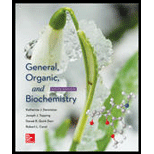
Concept explainers
(a)
Interpretation:
The IUPAC and common names of the given ester has to be written.
Concept Introduction:
Nomenclature of Esters
The simplest method to name an ester starts by identifying the carboxylic acid and alcohol.

The first part of the name of an ester is the alkyl or aryl group of the alcohol
- The name of the parent alcohol is identified and the name of the corresponding alkyl or aryl group is written.
The second part of the name is derived from the carboxylic acid
- The name of the parent carboxylic acid is identified and the suffix -ic is replaced with –ate.
(b)
Interpretation:
The IUPAC and common names of the given ester has to be written.
Concept Introduction:
Nomenclature of Esters
The simplest method to name an ester starts by identifying the carboxylic acid and alcohol.

The first part of the name of an ester is the alkyl or aryl group of the alcohol
- The name of the parent alcohol is identified and the name of the corresponding alkyl or aryl group is written.
The second part of the name is derived from the carboxylic acid
- The name of the parent carboxylic acid is identified and the suffix -ic is replaced with –ate.
(c)
Interpretation:
The IUPAC and common names of the given ester has to be written.
Concept Introduction:
Nomenclature of Esters
The simplest method to name an ester starts by identifying the carboxylic acid and alcohol.

The first part of the name of an ester is the alkyl or aryl group of the alcohol
- The name of the parent alcohol is identified and the name of the corresponding alkyl or aryl group is written.
The second part of the name is derived from the carboxylic acid
- The name of the parent carboxylic acid is identified and the suffix -ic is replaced with –ate.
(d)
Interpretation:
The IUPAC and common names of the given ester has to be written.
Concept Introduction:
Nomenclature of Esters
The simplest method to name an ester starts by identifying the carboxylic acid and alcohol.

The first part of the name of an ester is the alkyl or aryl group of the alcohol
- The name of the parent alcohol is identified and the name of the corresponding alkyl or aryl group is written.
The second part of the name is derived from the carboxylic acid
- The name of the parent carboxylic acid is identified and the suffix -ic is replaced with –ate.
Want to see the full answer?
Check out a sample textbook solution
Chapter 14 Solutions
General, Organic, and Biochemistry
 ChemistryChemistryISBN:9781305957404Author:Steven S. Zumdahl, Susan A. Zumdahl, Donald J. DeCostePublisher:Cengage Learning
ChemistryChemistryISBN:9781305957404Author:Steven S. Zumdahl, Susan A. Zumdahl, Donald J. DeCostePublisher:Cengage Learning ChemistryChemistryISBN:9781259911156Author:Raymond Chang Dr., Jason Overby ProfessorPublisher:McGraw-Hill Education
ChemistryChemistryISBN:9781259911156Author:Raymond Chang Dr., Jason Overby ProfessorPublisher:McGraw-Hill Education Principles of Instrumental AnalysisChemistryISBN:9781305577213Author:Douglas A. Skoog, F. James Holler, Stanley R. CrouchPublisher:Cengage Learning
Principles of Instrumental AnalysisChemistryISBN:9781305577213Author:Douglas A. Skoog, F. James Holler, Stanley R. CrouchPublisher:Cengage Learning Organic ChemistryChemistryISBN:9780078021558Author:Janice Gorzynski Smith Dr.Publisher:McGraw-Hill Education
Organic ChemistryChemistryISBN:9780078021558Author:Janice Gorzynski Smith Dr.Publisher:McGraw-Hill Education Chemistry: Principles and ReactionsChemistryISBN:9781305079373Author:William L. Masterton, Cecile N. HurleyPublisher:Cengage Learning
Chemistry: Principles and ReactionsChemistryISBN:9781305079373Author:William L. Masterton, Cecile N. HurleyPublisher:Cengage Learning Elementary Principles of Chemical Processes, Bind...ChemistryISBN:9781118431221Author:Richard M. Felder, Ronald W. Rousseau, Lisa G. BullardPublisher:WILEY
Elementary Principles of Chemical Processes, Bind...ChemistryISBN:9781118431221Author:Richard M. Felder, Ronald W. Rousseau, Lisa G. BullardPublisher:WILEY





